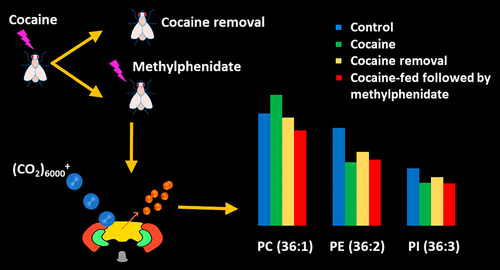当前位置:
X-MOL 学术
›
ACS Chem. Neurosci.
›
论文详情
Our official English website, www.x-mol.net, welcomes your feedback! (Note: you will need to create a separate account there.)
Interplay between Cocaine, Drug Removal, and Methylphenidate Reversal on Phospholipid Alterations in Drosophila Brain Determined by Imaging Mass Spectrometry.
ACS Chemical Neuroscience ( IF 5 ) Pub Date : 2020-02-21 , DOI: 10.1021/acschemneuro.0c00014 Mai Hoang Philipsen 1 , Nhu T N Phan 1, 2 , John Stephen Fletcher 1, 2 , Andrew G Ewing 1, 2, 3
ACS Chemical Neuroscience ( IF 5 ) Pub Date : 2020-02-21 , DOI: 10.1021/acschemneuro.0c00014 Mai Hoang Philipsen 1 , Nhu T N Phan 1, 2 , John Stephen Fletcher 1, 2 , Andrew G Ewing 1, 2, 3
Affiliation

|
Cocaine dependence displays a broad impairment in cognitive performance including attention, learning, and memory. To obtain a better understanding of the action of cocaine in the nervous system, and the relation between phospholipids and memory, we have investigated whether phospholipids recover in the brain following cocaine removal using the fly model, Drosophila melanogaster. In addition, the effects of methylphenidate, a substitute medication for cocaine dependence, on fly brain lipids after cocaine abuse are also determined to see if it can rescue the lipid changes caused by cocaine. Time of flight secondary ion mass spectrometry with a (CO2)6000+ gas cluster ion beam was used to detect intact phospholipids. We show that cocaine has persistent effects, both increasing and decreasing the levels of specific phosphatidylethanolamines and phosphatidylinositols. These changes remain after cocaine withdrawal and are not rescued by methylphenidate. Cocaine is again shown to generally increase the levels of phosphatidylcholines in the fly brain; however, after drug withdrawal, the abundance of these lipids returns to the original level and methylphenidate treatment of the flies following cocaine exposure enhances the reversal of the lipid level reducing them below the original control. The study provides insight into the molecular effects of cocaine and methylphenidate on brain lipids. We suggest that phosphatidylcholines could be a potential target for the treatment of cocaine abuse as well as be a significant hallmark of cognition and memory loss with cocaine.
中文翻译:

可卡因,药物去除和哌醋甲酯逆转对果蝇大脑中磷脂变化的相互作用(通过成像质谱法确定)。
可卡因依赖性显示出认知能力的广泛损害,包括注意力,学习和记忆。为了更好地了解可卡因在神经系统中的作用以及磷脂和记忆之间的关系,我们使用果蝇果蝇模型研究了可卡因去除后磷脂在大脑中是否恢复。此外,还测定了可卡因依赖的替代药物哌醋甲酯对滥用可卡因后苍蝇脑脂质的影响,以了解其能否挽救可卡因引起的脂质变化。使用(CO2)6000+气体团簇离子束的飞行时间二次离子质谱法检测完整的磷脂。我们证明可卡因具有持久作用,增加和减少特定磷脂酰乙醇胺和磷脂酰肌醇的水平。这些变化在撤回可卡因后仍然存在,而哌醋甲酯无法挽救。再次显示可卡因通常会增加苍蝇大脑中的磷脂酰胆碱水平。然而,停药后,这些脂质的丰度恢复到原始水平,可卡因暴露后果蝇的哌醋甲酯处理增强了脂质水平的逆转,使它们降至原始对照以下。该研究提供了可卡因和哌醋甲酯对脑脂质的分子作用的见解。我们建议磷脂酰胆碱可能是可卡因滥用治疗的潜在靶点,并且是可卡因认知和记忆丧失的重要标志。这些变化在撤回可卡因后仍然存在,而哌醋甲酯无法挽救。再次显示可卡因通常会增加苍蝇大脑中的磷脂酰胆碱水平。然而,停药后,这些脂质的丰度恢复到原始水平,可卡因暴露后果蝇的哌醋甲酯处理增强了脂质水平的逆转,使它们降至原始对照以下。该研究提供了可卡因和哌醋甲酯对脑脂质的分子作用的见解。我们建议磷脂酰胆碱可能是可卡因滥用治疗的潜在靶点,并且是可卡因认知和记忆丧失的重要标志。这些变化在撤回可卡因后仍然存在,而哌醋甲酯无法挽救。再次显示可卡因通常会增加苍蝇大脑中的磷脂酰胆碱水平。然而,停药后,这些脂质的丰度恢复到原始水平,可卡因暴露后果蝇的哌醋甲酯处理增强了脂质水平的逆转,使它们降至原始对照以下。该研究提供了可卡因和哌醋甲酯对脑脂质的分子作用的见解。我们建议磷脂酰胆碱可能是可卡因滥用治疗的潜在靶点,并且是可卡因认知和记忆力丧失的重要标志。再次显示可卡因通常会增加苍蝇大脑中的磷脂酰胆碱水平。然而,停药后,这些脂质的丰度恢复到原始水平,可卡因暴露后果蝇的哌醋甲酯处理增强了脂质水平的逆转,使它们降至原始对照以下。该研究提供了可卡因和哌醋甲酯对脑脂质的分子作用的见解。我们建议磷脂酰胆碱可能是可卡因滥用治疗的潜在靶点,并且是可卡因认知和记忆丧失的重要标志。再次显示可卡因通常会增加苍蝇大脑中的磷脂酰胆碱水平。然而,停药后,这些脂质的丰度恢复到原始水平,可卡因暴露后果蝇的哌醋甲酯处理增强了脂质水平的逆转,使它们降至原始对照以下。该研究提供了可卡因和哌醋甲酯对脑脂质的分子作用的见解。我们建议磷脂酰胆碱可能是可卡因滥用治疗的潜在靶点,并且是可卡因认知和记忆丧失的重要标志。这些脂质的丰度恢复到原始水平,可卡因暴露后果蝇的哌醋甲酯处理增强了脂质水平的逆转,使它们降至原始对照以下。该研究提供了可卡因和哌醋甲酯对脑脂质的分子作用的见解。我们建议磷脂酰胆碱可能是可卡因滥用治疗的潜在靶点,并且是可卡因认知和记忆丧失的重要标志。这些脂质的丰度恢复到原始水平,可卡因暴露后果蝇的哌醋甲酯处理增强了脂质水平的逆转,使它们降至原始对照以下。该研究提供了可卡因和哌醋甲酯对脑脂质的分子作用的见解。我们建议磷脂酰胆碱可能是可卡因滥用治疗的潜在靶点,并且是可卡因认知和记忆力丧失的重要标志。
更新日期:2020-02-23
中文翻译:

可卡因,药物去除和哌醋甲酯逆转对果蝇大脑中磷脂变化的相互作用(通过成像质谱法确定)。
可卡因依赖性显示出认知能力的广泛损害,包括注意力,学习和记忆。为了更好地了解可卡因在神经系统中的作用以及磷脂和记忆之间的关系,我们使用果蝇果蝇模型研究了可卡因去除后磷脂在大脑中是否恢复。此外,还测定了可卡因依赖的替代药物哌醋甲酯对滥用可卡因后苍蝇脑脂质的影响,以了解其能否挽救可卡因引起的脂质变化。使用(CO2)6000+气体团簇离子束的飞行时间二次离子质谱法检测完整的磷脂。我们证明可卡因具有持久作用,增加和减少特定磷脂酰乙醇胺和磷脂酰肌醇的水平。这些变化在撤回可卡因后仍然存在,而哌醋甲酯无法挽救。再次显示可卡因通常会增加苍蝇大脑中的磷脂酰胆碱水平。然而,停药后,这些脂质的丰度恢复到原始水平,可卡因暴露后果蝇的哌醋甲酯处理增强了脂质水平的逆转,使它们降至原始对照以下。该研究提供了可卡因和哌醋甲酯对脑脂质的分子作用的见解。我们建议磷脂酰胆碱可能是可卡因滥用治疗的潜在靶点,并且是可卡因认知和记忆丧失的重要标志。这些变化在撤回可卡因后仍然存在,而哌醋甲酯无法挽救。再次显示可卡因通常会增加苍蝇大脑中的磷脂酰胆碱水平。然而,停药后,这些脂质的丰度恢复到原始水平,可卡因暴露后果蝇的哌醋甲酯处理增强了脂质水平的逆转,使它们降至原始对照以下。该研究提供了可卡因和哌醋甲酯对脑脂质的分子作用的见解。我们建议磷脂酰胆碱可能是可卡因滥用治疗的潜在靶点,并且是可卡因认知和记忆丧失的重要标志。这些变化在撤回可卡因后仍然存在,而哌醋甲酯无法挽救。再次显示可卡因通常会增加苍蝇大脑中的磷脂酰胆碱水平。然而,停药后,这些脂质的丰度恢复到原始水平,可卡因暴露后果蝇的哌醋甲酯处理增强了脂质水平的逆转,使它们降至原始对照以下。该研究提供了可卡因和哌醋甲酯对脑脂质的分子作用的见解。我们建议磷脂酰胆碱可能是可卡因滥用治疗的潜在靶点,并且是可卡因认知和记忆力丧失的重要标志。再次显示可卡因通常会增加苍蝇大脑中的磷脂酰胆碱水平。然而,停药后,这些脂质的丰度恢复到原始水平,可卡因暴露后果蝇的哌醋甲酯处理增强了脂质水平的逆转,使它们降至原始对照以下。该研究提供了可卡因和哌醋甲酯对脑脂质的分子作用的见解。我们建议磷脂酰胆碱可能是可卡因滥用治疗的潜在靶点,并且是可卡因认知和记忆丧失的重要标志。再次显示可卡因通常会增加苍蝇大脑中的磷脂酰胆碱水平。然而,停药后,这些脂质的丰度恢复到原始水平,可卡因暴露后果蝇的哌醋甲酯处理增强了脂质水平的逆转,使它们降至原始对照以下。该研究提供了可卡因和哌醋甲酯对脑脂质的分子作用的见解。我们建议磷脂酰胆碱可能是可卡因滥用治疗的潜在靶点,并且是可卡因认知和记忆丧失的重要标志。这些脂质的丰度恢复到原始水平,可卡因暴露后果蝇的哌醋甲酯处理增强了脂质水平的逆转,使它们降至原始对照以下。该研究提供了可卡因和哌醋甲酯对脑脂质的分子作用的见解。我们建议磷脂酰胆碱可能是可卡因滥用治疗的潜在靶点,并且是可卡因认知和记忆丧失的重要标志。这些脂质的丰度恢复到原始水平,可卡因暴露后果蝇的哌醋甲酯处理增强了脂质水平的逆转,使它们降至原始对照以下。该研究提供了可卡因和哌醋甲酯对脑脂质的分子作用的见解。我们建议磷脂酰胆碱可能是可卡因滥用治疗的潜在靶点,并且是可卡因认知和记忆力丧失的重要标志。



























 京公网安备 11010802027423号
京公网安备 11010802027423号